tow PONTIAC VIBE 2007 Service Manual
[x] Cancel search | Manufacturer: PONTIAC, Model Year: 2007, Model line: VIBE, Model: PONTIAC VIBE 2007Pages: 432, PDF Size: 2.54 MB
Page 268 of 432

When You Are Ready to Leave After
Parking on a Hill
1. Apply your regular brakes and hold the pedal
down while you:
start your engine
shift into a gear, and
release the parking brake
2. Let up on the brake pedal.
3. Drive slowly until the trailer is clear of the
chocks.
4. Stop and have someone pick up and store the
chocks.
Maintenance When Trailer Towing
Your vehicle will need service more often when
you’re pulling a trailer. See the Maintenance
Schedule for more on this. Things that are
especially important in trailer operation are
automatic transaxle �uid (don’t over�ll), engine oil,
drive belt, cooling system and brake system.
Each of these is covered in this manual, and the
Index will help you �nd them quickly. If you’re
trailering, it’s a good idea to review this information
before you start your trip.
Check periodically to see that all hitch nuts and
bolts are tight.
Engine Cooling When Trailer Towing
Your cooling system may temporarily overheat
during severe operating conditions. SeeEngine
Overheating on page 297.
268
Page 281 of 432
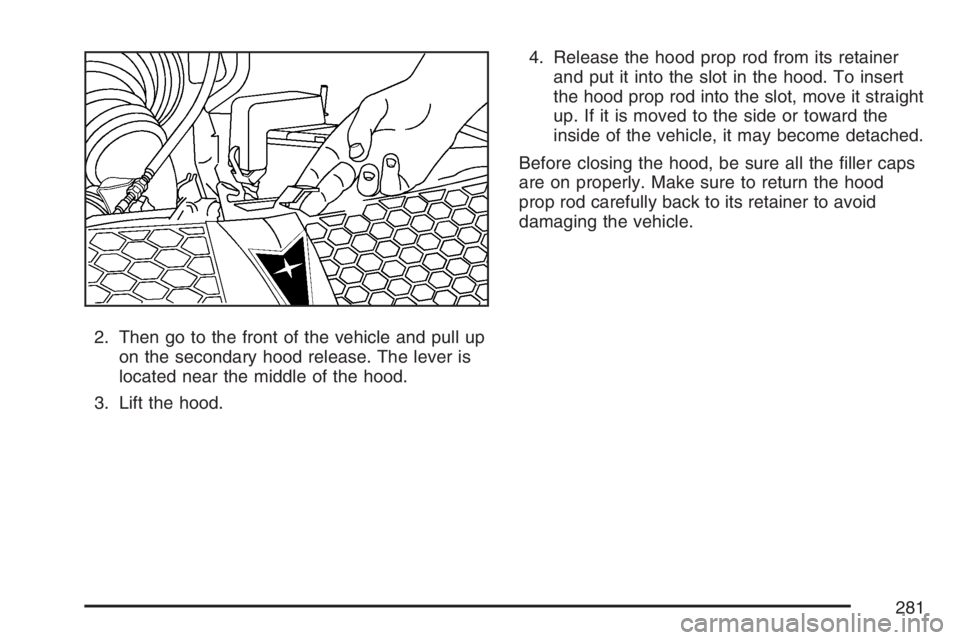
2. Then go to the front of the vehicle and pull up
on the secondary hood release. The lever is
located near the middle of the hood.
3. Lift the hood.4. Release the hood prop rod from its retainer
and put it into the slot in the hood. To insert
the hood prop rod into the slot, move it straight
up. If it is moved to the side or toward the
inside of the vehicle, it may become detached.
Before closing the hood, be sure all the �ller caps
are on properly. Make sure to return the hood
prop rod carefully back to its retainer to avoid
damaging the vehicle.
281
Page 284 of 432
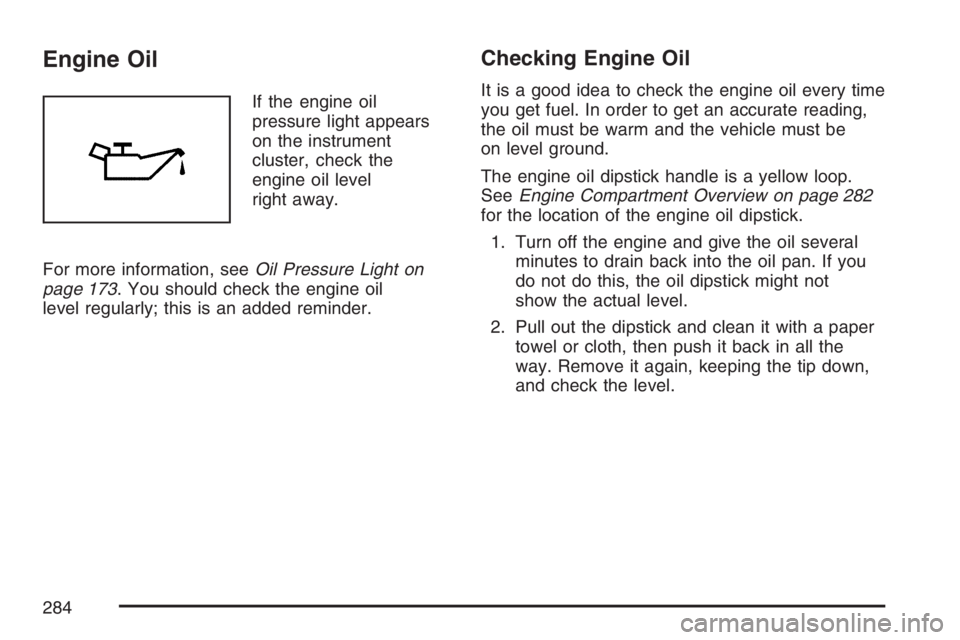
Engine Oil
If the engine oil
pressure light appears
on the instrument
cluster, check the
engine oil level
right away.
For more information, seeOil Pressure Light on
page 173. You should check the engine oil
level regularly; this is an added reminder.
Checking Engine Oil
It is a good idea to check the engine oil every time
you get fuel. In order to get an accurate reading,
the oil must be warm and the vehicle must be
on level ground.
The engine oil dipstick handle is a yellow loop.
SeeEngine Compartment Overview on page 282
for the location of the engine oil dipstick.
1. Turn off the engine and give the oil several
minutes to drain back into the oil pan. If you
do not do this, the oil dipstick might not
show the actual level.
2. Pull out the dipstick and clean it with a paper
towel or cloth, then push it back in all the
way. Remove it again, keeping the tip down,
and check the level.
284
Page 291 of 432

Checking the Fluid Level
Prepare your vehicle as follows:
1. Park your vehicle on a level place. Keep the
engine running.
2. With the parking brake applied, place the shift
lever in PARK (P).
3. With your foot on the brake pedal, move the
shift lever through each gear range, pausing
for about three seconds in each range.
Then, position the shift lever in PARK (P).
4. Let the engine run at idle for three to
�ve minutes.Then, without shutting off the engine, follow
these steps:
The automatic transaxle dipstick has an orange
handle and is located near the front of the engine
compartment. SeeEngine Compartment Overview
on page 282for more information on location.
1. Release the tab and pull out the dipstick and
wipe it with a clean rag or paper towel.
2. Push it back in all the way, wait three seconds
and then pull it back out again.
3. Check both sides of the dipstick, and read the
lower level. The �uid level must be between
the two dimples in the hot range.
4. If the �uid level is in the acceptable range,
push the dipstick back in all the way; then
press the tab down to lock the dipstick in place.
291
Page 298 of 432

If No Steam Is Coming From
Your Engine
If you get an engine overheat warning but see or
hear no steam, the problem may not be too
serious. Sometimes the engine can get a little too
hot when you:
Climb a long hill on a hot day.
Stop after high-speed driving.
Idle for long periods in traffic.
Tow a trailer.
If you get the overheat warning with no sign of
steam, try this for a minute or so:
1. In heavy traffic, let the engine idle in
NEUTRAL (N) while stopped. If it is safe to do
so, pull off the road, shift to PARK (P) or
NEUTRAL (N) and let the engine idle.
2. Turn on your heater to full hot at the highest
fan speed and open the windows as
necessary.If you no longer have the overheat warning, you
can drive. Just to be safe, drive slower for
about 10 minutes. If the warning does not come
back on, you can drive normally.
If the warning continues and you have not
stopped, pull over, stop, and park your vehicle
right away.
If there is still no sign of steam, you can idle the
engine for three minutes while you are parked.
If you still have the warning, turn off the engine
and get everyone out of the vehicle until it
cools down.
You may decide not to lift the hood but to get
service help right away.
298
Page 321 of 432
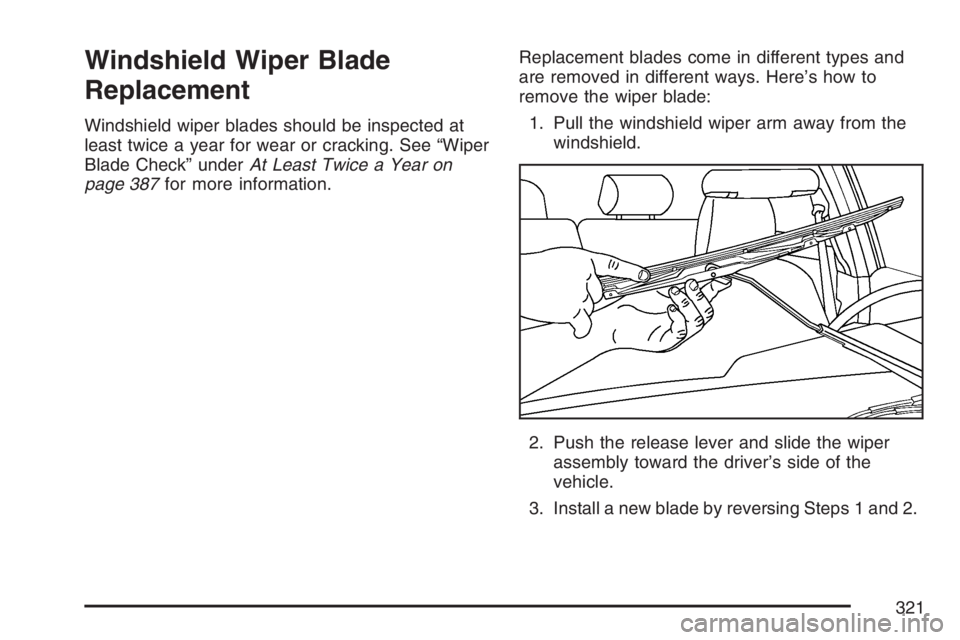
Windshield Wiper Blade
Replacement
Windshield wiper blades should be inspected at
least twice a year for wear or cracking. See “Wiper
Blade Check” underAt Least Twice a Year on
page 387for more information.Replacement blades come in different types and
are removed in different ways. Here’s how to
remove the wiper blade:
1. Pull the windshield wiper arm away from the
windshield.
2. Push the release lever and slide the wiper
assembly toward the driver’s side of the
vehicle.
3. Install a new blade by reversing Steps 1 and 2.
321
Page 333 of 432
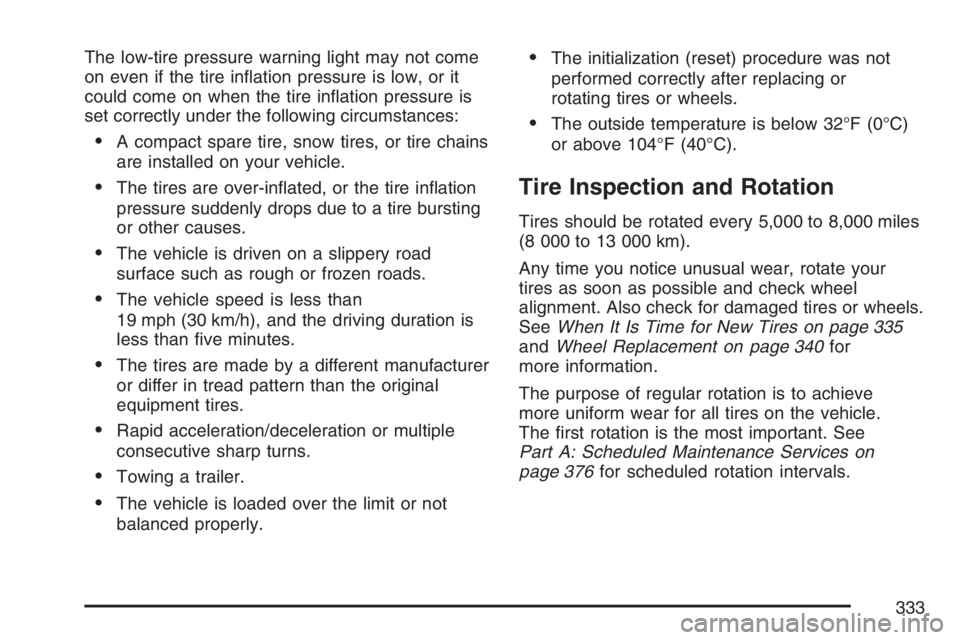
The low-tire pressure warning light may not come
on even if the tire in�ation pressure is low, or it
could come on when the tire in�ation pressure is
set correctly under the following circumstances:
A compact spare tire, snow tires, or tire chains
are installed on your vehicle.
The tires are over-in�ated, or the tire in�ation
pressure suddenly drops due to a tire bursting
or other causes.
The vehicle is driven on a slippery road
surface such as rough or frozen roads.
The vehicle speed is less than
19 mph (30 km/h), and the driving duration is
less than �ve minutes.
The tires are made by a different manufacturer
or differ in tread pattern than the original
equipment tires.
Rapid acceleration/deceleration or multiple
consecutive sharp turns.
Towing a trailer.
The vehicle is loaded over the limit or not
balanced properly.
The initialization (reset) procedure was not
performed correctly after replacing or
rotating tires or wheels.
The outside temperature is below 32°F (0°C)
or above 104°F (40°C).
Tire Inspection and Rotation
Tires should be rotated every 5,000 to 8,000 miles
(8 000 to 13 000 km).
Any time you notice unusual wear, rotate your
tires as soon as possible and check wheel
alignment. Also check for damaged tires or wheels.
SeeWhen It Is Time for New Tires on page 335
andWheel Replacement on page 340for
more information.
The purpose of regular rotation is to achieve
more uniform wear for all tires on the vehicle.
The �rst rotation is the most important. See
Part A: Scheduled Maintenance Services on
page 376for scheduled rotation intervals.
333
Page 334 of 432
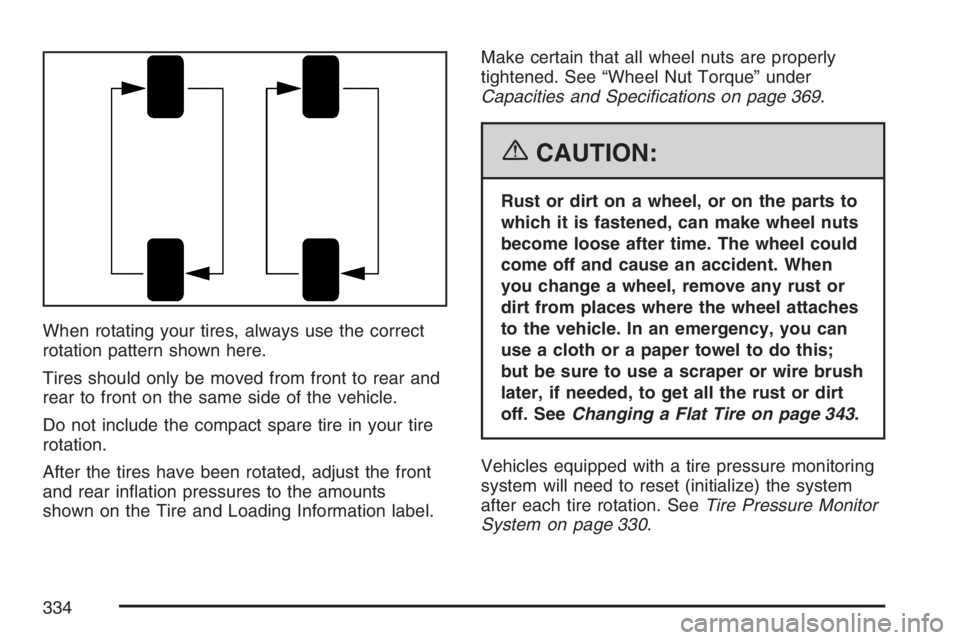
When rotating your tires, always use the correct
rotation pattern shown here.
Tires should only be moved from front to rear and
rear to front on the same side of the vehicle.
Do not include the compact spare tire in your tire
rotation.
After the tires have been rotated, adjust the front
and rear in�ation pressures to the amounts
shown on the Tire and Loading Information label.Make certain that all wheel nuts are properly
tightened. See “Wheel Nut Torque” under
Capacities and Speci�cations on page 369.
{CAUTION:
Rust or dirt on a wheel, or on the parts to
which it is fastened, can make wheel nuts
become loose after time. The wheel could
come off and cause an accident. When
you change a wheel, remove any rust or
dirt from places where the wheel attaches
to the vehicle. In an emergency, you can
use a cloth or a paper towel to do this;
but be sure to use a scraper or wire brush
later, if needed, to get all the rust or dirt
off. SeeChanging a Flat Tire on page 343.
Vehicles equipped with a tire pressure monitoring
system will need to reset (initialize) the system
after each tire rotation. SeeTire Pressure Monitor
System on page 330.
334
Page 342 of 432
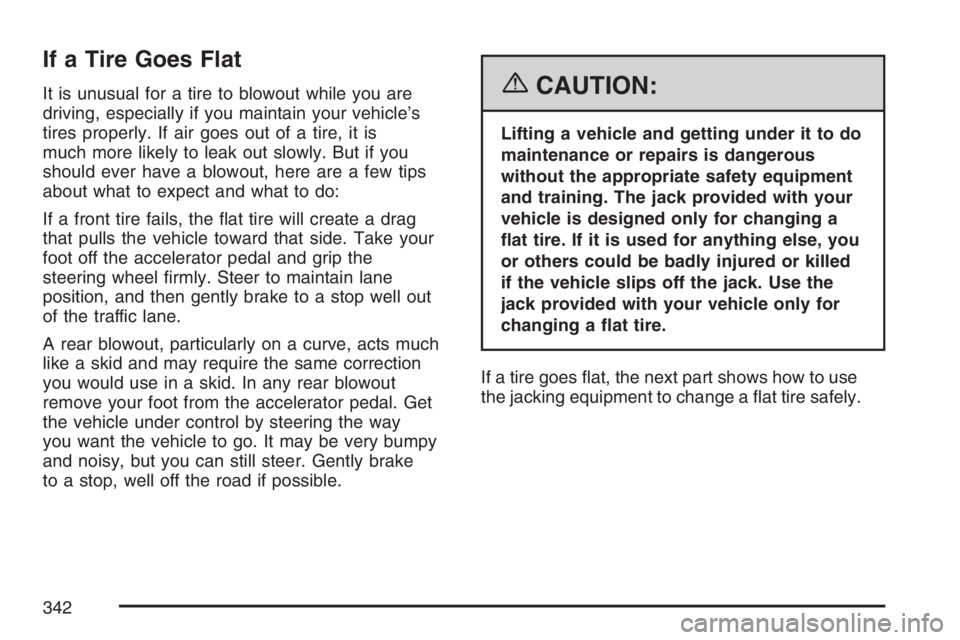
If a Tire Goes Flat
It is unusual for a tire to blowout while you are
driving, especially if you maintain your vehicle’s
tires properly. If air goes out of a tire, it is
much more likely to leak out slowly. But if you
should ever have a blowout, here are a few tips
about what to expect and what to do:
If a front tire fails, the �at tire will create a drag
that pulls the vehicle toward that side. Take your
foot off the accelerator pedal and grip the
steering wheel �rmly. Steer to maintain lane
position, and then gently brake to a stop well out
of the traffic lane.
A rear blowout, particularly on a curve, acts much
like a skid and may require the same correction
you would use in a skid. In any rear blowout
remove your foot from the accelerator pedal. Get
the vehicle under control by steering the way
you want the vehicle to go. It may be very bumpy
and noisy, but you can still steer. Gently brake
to a stop, well off the road if possible.{CAUTION:
Lifting a vehicle and getting under it to do
maintenance or repairs is dangerous
without the appropriate safety equipment
and training. The jack provided with your
vehicle is designed only for changing a
�at tire. If it is used for anything else, you
or others could be badly injured or killed
if the vehicle slips off the jack. Use the
jack provided with your vehicle only for
changing a �at tire.
If a tire goes �at, the next part shows how to use
the jacking equipment to change a �at tire safely.
342
Page 344 of 432
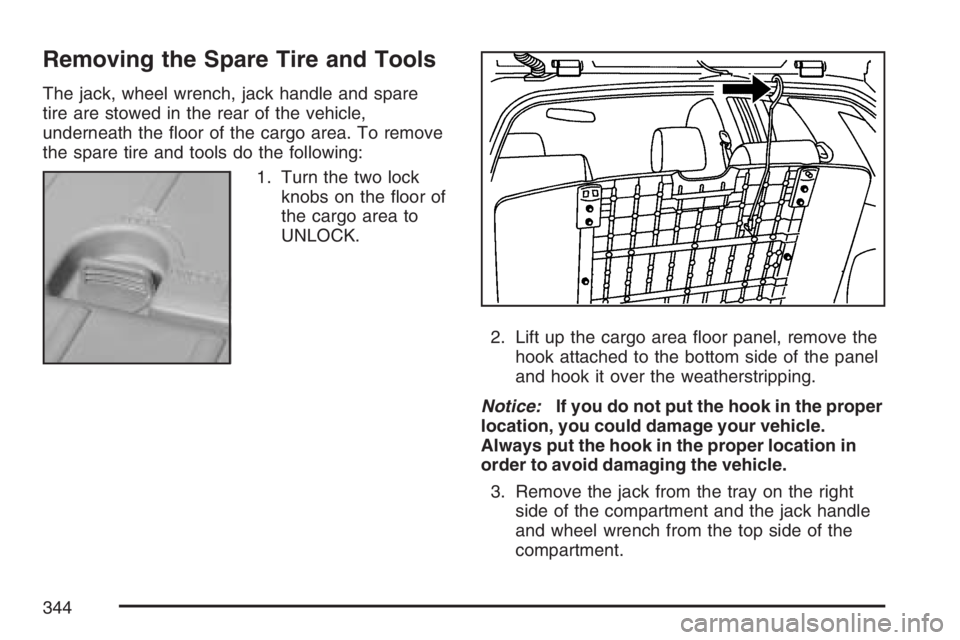
Removing the Spare Tire and Tools
The jack, wheel wrench, jack handle and spare
tire are stowed in the rear of the vehicle,
underneath the �oor of the cargo area. To remove
the spare tire and tools do the following:
1. Turn the two lock
knobs on the �oor of
the cargo area to
UNLOCK.
2. Lift up the cargo area �oor panel, remove the
hook attached to the bottom side of the panel
and hook it over the weatherstripping.
Notice:If you do not put the hook in the proper
location, you could damage your vehicle.
Always put the hook in the proper location in
order to avoid damaging the vehicle.
3. Remove the jack from the tray on the right
side of the compartment and the jack handle
and wheel wrench from the top side of the
compartment.
344